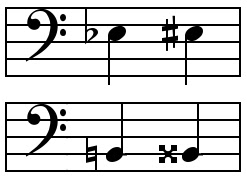Adjacent Keys - keys on a piano that are located directly to the right or left of each other. For example the C key is adjacent to both B & C#.
In the above image, the keys that touch one another are adjacent. Each adjacent key forms a semitone/half-step.
Semitone/Half-step - adjacent keys on the piano keyboard are semitones or half-tones.
Diatonic Semitone (DST) - a semitone in which one note of the semitone is written on a line and the other is written on a space on the staff or vice versa.
These two notes for a diatonic semitone.
These notes also form a DST.
Chromatic Semitone (CST) - a semitone in which both notes are on the same line or space of the staff.
Both of these are examples of CST's.
Accidentals: 
The double sharp raises a pitch two semitones.
The sharp raises a pitch one semitone.
The natural cancels any preceding accidentals, returning to the original pitch.
The flat lowers a pitch one semitone.
The double flat lowers a pitch two semitones.
Whole Tone/Whole Step - Two semitones form a whole tone or a whole step.
- On the above keyboard, a whole tone occurs every other key.
Both of these note whole tones. There are two semitones between A and B as well as between E and F 
This is another way to notate whole tones. Again, there are two semitones between Eb and E# as well as between B and B double-sharp.
The Major Scale Form - the major scale is made up of 8 scale degrees. It consists of five whole tones and two semitones. The whole tones are located between degress 1 & 2, 2 & 3, 4 & 5, 5 & 6, and 6 & 7; the semitones are located between degrees 3 & 4 and 7 & 8.
Scale Degrees - are noted with the carret (^) above the degree number.
Note the semitones between 3 & 4 and 7 & 8 are DSTs. The whole tones otherwise noted are called diatonic whole tones and like diatonic semitones, they are whole tones that occur with one note on a line and the other note on a space.
Tonic - the tonic is the first and the eighth degree of the scale. These two pitches are an octave apart and therefore have the same note name.
If you were to write out the names of the notes in a scale, you would be spelling the scale. For example to spell the Bb Major scale you would write Bb C D Eb F G A Bb. Notice the DSTs between D and Eb and A and Bb, making this scale major.
21.4.08
Whole Tones, Semitones, Accidentals & The Major Scale
Labels:
accidental,
carret,
double flat,
double sharp,
flat,
major scale,
natural,
scale degrees,
semitone,
sharp,
spelling scales,
tonic,
whole tone
20.4.08
Rhythm, Notes, Rests, Dots, and Triplets
Rhythm - patterns of duration and accent of musical sounds moving through time.
Note Value - also called time value, the term used to refer to the duration of a sound.
Note Values
- Whole Note - the longest note value
- Half Note - half of a whole note; two halfs in a whole
- Quarter Note - half of a half note; two quarters in a half, four in a whole
- Eighth Note - half of a quarter note; two eighths in a quarter, four in a half and eight in a whole note
- Sixteenth Note - half of an eighth; two in an eighth, four in a quarter, eight in a half and sixteen in a whole

Parts of a Music Note Symbol

- Notehead - either hollow or solid
- Stem - attached to the notehead; can go up or down
- Flag - attached to eighth and shorter durations; each additional flag decreases the note value by half; always drawn to the right
- Beam - used to join flagged notes together
Rests - used to indicate durations of silence. Rest values are the same as note values - whole, half, quarter, eighth, sixteenth, etc.

- Whole Rest - hangs below the fourth line of the staff
- Half Rest - sits on top of the third line of the staff
- Quarter Rest
- Eighth Rest - uses hooks
- Sixteenth Rest - gains an additional hook for its diminished durational value
Dots and Triplets
Dots - affect the note value by adding one half to the duration

- dotted half note is equal to a half note plus a quarter note
- an undotted note is divided into two equal parts (quarter note = two eighths)
- a dotted note is divided into three (dotted eighth = three sixteeths)
- double dots indicate the note value to be increased by half of the preceding dot (double dotted half = half + quarter + eighth)
Triplets - notes normally divisible into two parts can be divided into three; the three notes will be written as notes symbols half the value of the original note value; when this is done it is called a triplet pattern. Additional symbols must be included to notate a triplet properly.

Subscribe to:
Posts (Atom)